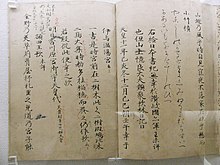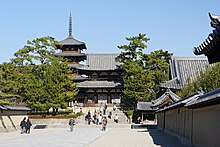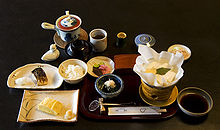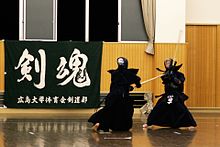Right panel of the Pine Trees screen (Shōrin-zu byōbu 松林図 屏風) by Hasegawa Tōhaku, c.1595
Language
A page from the Man'yōshū, the oldest anthology of classical Japanese poetry
Japanese is the official and primary language of Japan. Japanese has a lexically distinct pitch-accent system. Early Japanese is known largely on the basis of its state in the 8th century, when the three major works of Old Japanese were compiled. The earliest attestation of the Japanese language is in a Chinese document from 252 AD.
Japanese is written with a combination of three scripts: hiragana, derived from the Chinese cursive script, katakana, derived as a shorthand from Chinese characters, and kanji, imported from China. The Latin alphabet, rōmaji, is also often used in modern Japanese, especially for company names and logos, advertising, and when inputting Japanese into a computer. The Hindu-Arabic numerals are generally used for numbers, but traditional Sino-Japanese numerals are also very common.
Literature
Early works of Japanese literature were heavily influenced by cultural contact with China and Chinese literature, often written in Classical Chinese. Indian literature also had an influence through the spread of Buddhism throughout Japan. Eventually, Japanese literature developed into a separate style in its own right as Japanese writers began writing their own works about Japan. Since Japan reopened its ports to Western trading and diplomacy in the 19th century, Western and Eastern literature have strongly affected each other and continue to do so.Music
Fumie Hihara playing shamisen (Kabuki dance, Guimet Museum, Paris)
The music of Japan includes a wide array of performers in distinct styles both traditional and modern. The word for music in Japanese is 音楽 (ongaku), combining the kanji 音 "on" (sound) with the kanji 楽 "gaku" (enjoyment).[3] Japan is the second largest music market in the world, behind the United States, and the largest in Asia,[4] and most of the market is dominated by Japanese artists.
Local music often appears at karaoke venues, which is on lease from the record labels. Traditional Japanese music is quite different from Western Music and is based on the intervals of human breathing rather than mathematical timing.[citation needed] In 1873, a British traveler claimed that Japanese music, "exasperate(s) beyond all endurance the European breast."[5]
Visual arts
Painting
Painting has been an art in Japan for a very long time: the brush is a traditional writing and painting tool, and the extension of that to its use as an artist's tool was probably natural. Japanese painters are often categorized by what they painted, as most of them constrained themselves solely to subjects such as animals, landscapes, or figures. Chinese papermaking was introduced to Japan around the 7th century. Later, washi was developed from it. Native Japanese painting techniques are still in use today, as well as techniques adopted from continental Asia and from the West. Schools of painting such as the Kano school of the 16th century became known for their bold brush strokes and contrast between light and dark, especially after Oda Nobunaga and Tokugawa Ieyasu began to use this style. Famous Japanese painters include Kanō Sanraku, Maruyama Ōkyo, and Tani Bunchō.[6]
Calligraphy
The flowing, brush-drawn Japanese rendering of text itself is seen as a traditional art form as well as a means of conveying written information. The written work can consist of phrases, poems, stories, or even single characters. The style and format of the writing can mimic the subject matter, even to the point of texture and stroke speed. In some cases, it can take over one hundred attempts to produce the desired effect of a single character but the process of creating the work is considered as much an art as the end product itself.This calligraphy form is known as 'shodō' (書道) which literally means 'the way of writing or calligraphy' or more commonly known as 'shūji' (習字) 'learning how to write characters'. Commonly confused with Calligraphy is the art form known as 'sumi-e' (墨絵) literally means 'ink painting' which is the art of painting a scene or object.
Sculpture
Traditional Japanese sculptures mainly focused on Buddhist images, such as Tathagata, Bodhisattva, and Myō-ō. The oldest sculpture in Japan is a wooden statue of Amitābha at the Zenkō-ji temple. In the Nara period, Buddhist statues were made by the national government to boost its prestige. These examples are seen in present-day Nara and Kyoto, most notably a colossal bronze statue of the Buddha Vairocana in the Tōdai-ji temple.
Wood has traditionally been used as the chief material in Japan, along with traditional Japanese architecture. Statues are often lacquered, gilded, or brightly painted, although there are little traces on the surfaces. Bronze and other metals are not used. Other materials, such as stone and pottery, have had extremely important roles in the plebeian beliefs.
Ukiyo-e
Ukiyo-e, literally "pictures of the floating world", is a genre of woodblock prints that exemplifies the characteristics of pre-Meiji Japanese art. Because these prints could be mass-produced, they were available to a wide cross-section of the Japanese populace — those not wealthy enough to afford original paintings — during their heyday, from the 17th to 20th century.Ikebana
Ikebana (生け花, 活花, or 挿花) is the Japanese art of flower arrangement. It has gained widespread international fame for its focus on harmony, color use, rhythm, and elegantly simple design. It is an art centered greatly on expressing the seasons, and is meant to act as a symbol to something greater than the flower itself.Religion
Torii entrance gate at Kamigamo shrine, Kyoto
Buddhism and Shintoism are the primary religions of Japan.
Shintoism
Shintoism is an ethnic religion that focuses on ceremonies and rituals. In Shintoism, followers believe that kami, a Shinto deity or spirit, are present throughout nature, including rocks, trees, and mountains. Humans can also be considered to possess a kami. One of the goals of Shintoism is to maintain a connection between humans, nature, and kami. The religion developed in Japan prior to the sixth century CE, after which point followers built shrines to worship kami.[7]Buddhism
Buddha sculpture
Buddhism developed in India around the 6th and 4th centuries BCE and eventually spread through China and Korea. It arrived in Japan during the 6th century CE, where it was initially unpopular. Most Japanese people were unable to understand the difficult philosophical messages present in Buddhism, however they did have an appreciation for the religion's art, which is believed to have led to the religion growing more popular. Buddhism is concerned with the soul and life after dying. In the religion a person's status was unimportant, as every person would get sick, age, die, and eventually be reincarnated into a new life, a cycle called saṃsāra. The suffering people experienced during life was one way for people to gain a better future. The ultimate goal was to escape the cycle of death and rebirth by attaining true insight.[7]
Performing arts
Noh play at traditional Noh theatre
The four traditional theatres from Japan are noh (or nō), kyōgen, kabuki, and bunraku. Noh had its origins in the union of the sarugaku, with music and dance made by Kanami and Zeami Motokiyo.[8] Among the characteristic aspects of it are the masks, costumes, and the stylized gestures, sometimes accompanied by a fan that can represent other objects. The noh programs are presented in alternation with the ones of kyōgen, traditionally in number of five, but currently in groups of three.
The kyōgen, of humorous character, had older origin, in 8th century entertainment brought from China, developing itself in sarugaku. In kyōgen, masks are rarely used and even if the plays can be associated with the ones of noh, currently many are not.[8]
Kabuki appears in the beginning of the Edo period from the representations and dances of Izumo no Okuni in Kyoto.[9] Due to prostitution of actresses of kabuki, the participation of women in the plays was forbidden by the government in 1629, and the feminine characters had passed to be represented only by men (onnagata). Recent attempts to reintroduce actresses in kabuki had not been well accepted.[9] Another characteristic of kabuki is the use of makeup for the actors in historical plays (kumadori).
Japanese puppet theater bunraku developed in the same period, that kabuki in a competition and contribution relation involving actors and authors. The origin of bunraku, however is older, lies back in the Heian period.[10] In 1914, appeared the Takarazuka Revue a company solely composed by women who introduced the revue in Japan.[11]
Architecture
Hōryū-ji is widely known to be the oldest wooden architecture existing in the world.
Japanese architecture has as long of a history as any other aspect of Japanese culture. Originally heavily influenced by Chinese architecture, it has developed many differences and aspects which are indigenous to Japan. Examples of traditional architecture are seen at temples, Shinto shrines, and castles in Kyoto and Nara. Some of these buildings are constructed with traditional gardens, which are influenced from Zen ideas.
Some modern architects, such as Yoshio Taniguchi and Tadao Ando are known for their amalgamation of Japanese traditional and Western architectural influences.
Gardens
Garden architecture is as important as building architecture and very much influenced by the same historical and religious background. A primary design principle of a garden is the creation of the landscape based on, or at least greatly influenced by, the three-dimensional monochrome ink (sumi) landscape painting, sumi-e or suibokuga.
In Japan, the garden has the status of artwork.[12]
Traditional clothing
Woman in kimono at Fukuoka City Hall.
Traditional Japanese clothing distinguishes Japan from all other countries around the world. The Japanese word kimono means "something one wears" and they are the traditional garments of Japan. Originally, the word kimono was used for all types of clothing, but eventually, it came to refer specifically to the full-length garment also known as the naga-gi, meaning "long-wear", that is still worn today on special occasions by women, men, and children. The earliest kimonos were heavily influenced by traditional Han Chinese clothing, known today as hanfu (漢服, kanfuku in Japanese), through Japanese embassies to China which resulted in extensive Chinese culture adoptions by Japan, as early as the 5th century AD.[13] It was during the 8th century, however, that Chinese fashions came into style among the Japanese, and the overlapping collar became particularly women's fashion.[13] Kimono in this meaning plus all other items of traditional Japanese clothing is known collectively as wafuku which means "Japanese clothes" as opposed to yofuku (Western-style clothing). Kimonos come in a variety of colors, styles, and sizes. Men mainly wear darker or more muted colors, while women tend to wear brighter colors and pastels, and, especially for younger women, often with complicated abstract or floral patterns.
The kimono of a woman who is married (tomesode) differs from the kimono of a woman who is not married (furisode). The tomesode sets itself apart because the patterns do not go above the waistline. The furisode can be recognized by its extremely long sleeves spanning anywhere from 39 to 42 inches, it is also the most formal kimono an unwed woman wears. The furisode advertises that a woman is not only of age but also single.
The style of kimono also changes with the season, in spring kimonos are vibrantly colored with springtime flowers embroidered on them. In Autumn, kimono colors are not as bright, with Autumn patterns. Flannel kimonos are most commonly worn in winter; they are made of a heavier material and are worn mainly to stay warm.
One of the more elegant kimonos is the uchikake, a long silk overgarment worn by the bride in a wedding ceremony. The uchikake is commonly embellished with birds or flowers using silver and gold thread.
Kimonos do not come in specific sizes as most western dresses do. The sizes are only approximate, and a special technique is used to fit the dress appropriately.
The obi is a very important part of the kimono. Obi is a decorative sash that is worn by Japanese men and women, although it can be worn with many different traditional outfits, it is most commonly worn with the kimono. Most women wear a very large elaborate obi, while men typically don a more thin and conservative obi.
Most Japanese men only wear the kimono at home or in a very laid back environment, however it is acceptable for a man to wear the kimono when he is entertaining guests in his home. For a more formal event a Japanese man might wear the haori and hakama, a half coat and divided skirt. The hakama is tied at the waist, over the kimono and ends near the ankle. Hakama were initially intended for men only, but today it is acceptable for women to wear them as well. Hakama can be worn with types of kimono, excluding the summer version, yukata. The lighter and simpler casual-wear version of kimono often worn in Japanese summer festival is called yukata.
Formal kimonos are typically worn in several layers, with number of layers, visibility of layers, sleeve length, and choice of pattern dictated by social status, season, and the occasion for which the kimono is worn. Because of the mass availability, most Japanese people wear western style clothing in their everyday life, and kimonos are mostly worn for festivals, and special events. As a result, most young women in Japan are not able to put the kimono on themselves. Many older women offer classes to teach these young women how to don the traditional clothing.
Happi is another type of traditional clothing, but it is not famous worldwide like the kimono. A happi (or happy coat) is a straight sleeved coat that is typically imprinted with the family crest, and was a common coat for firefighters to wear.
Japan also has very distinct footwear.
Tabi, an ankle high sock, is often worn with the kimono. Tabi are designed to be worn with geta, a type of thonged footwear. Geta are sandals mounted on wooden blocks held to the foot by a piece of fabric that slides between the toes. Geta are worn both by men and women with the kimono or yukata.
Cuisine
Traditional breakfast at ryokan
Through a long culinary past, the Japanese have developed sophisticated and refined cuisine. In more recent years, Japanese food has become fashionable and popular in the United States, Europe, and many other areas. Dishes such as sushi, tempura, noodles, and teriyaki are some of the foods that are commonly known. The Japanese diet consists principally of rice; fresh, lean seafood; and pickled or boiled vegetables. The healthy Japanese diet is often believed to be related to the longevity of Japanese people.
Sports and leisure
Two students practicing kendo at Hiroshima University
In the long feudal period governed by the samurai class, some methods that were used to train warriors were developed into well-ordered martial arts, in modern times referred to collectively as koryū. Examples include kenjutsu, kendo, kyūdō, sōjutsu, jujutsu, and sumo, all of which were established in the Edo period. After the rapid social change in the Meiji Restoration, some martial arts changed into modern sports, called gendai budō. Judo was developed by Kanō Jigorō, who studied some sects of jujutsu. These sports are still widely practiced in present-day Japan and other countries.
Baseball, Association football, and other popular western sports were imported to Japan in the Meiji period. These sports are commonly practiced in schools, along with traditional martial arts.
Baseball, soccer, football, and ping pong are the most popular sports in Japan. Association football gained prominence in Japan after the J League (Japan Professional Football League) was established in 1991. Japan also co-hosted the 2002 FIFA World Cup. In addition, there are many semi-professional organizations, which are sponsored by private companies: for example, volleyball, basketball, rugby union, table tennis, and so on.
Popular culture
Japanese popular culture not only reflects the attitudes and concerns of the present day, but also provides a link to the past. Popular films, television programs, manga, music, anime and video games all developed from older artistic and literary traditions, and many of their themes and styles of presentation can be traced to traditional art forms. Contemporary forms of popular culture, much like the traditional forms, provide not only entertainment but also an escape for the contemporary Japanese from the problems of an industrial world.
When asked how they spent their leisure time, 80 percent of a sample of men and women surveyed by the government in 1986 said they averaged about two and a half hours per weekday watching television, listening to the radio, and reading newspapers or magazines. Some 16 percent spent an average of two and a quarter hours a day engaged in hobbies or amusements. Others spent leisure time participating in sports, socializing, and personal study. Teenagers and retired people reported more time spent on all of these activities than did other groups.[citation needed]
Many anime and manga are very popular around the world and continue to become popular, as well as Japanese video games, fashion, and game shows.[14]
In the late 1980s, the family was the focus of leisure activities, such as excursions to parks or shopping districts. Although Japan is often thought of as a hard-working society with little time for leisure, the Japanese seek entertainment wherever they can. It is common to see Japanese commuters riding the train to work, enjoying their favorite manga, or listening through earphones to the latest in popular music on portable music players.
A wide variety of types of popular entertainment are available. There is a large selection of music, films, and the products of a huge comic book industry, among other forms of entertainment, from which to choose. Game centers, bowling alleys, and karaoke are popular hangout places for teens while older people may play shogi or go in specialized parlors.
Together, the publishing, film/video, music/audio, and game industries in Japan make up the growing Japanese content industry.[15]
National character
Cultural map of the world according to the World Values Survey, describing Japan as highest in the world in "Secular-Rational Values"
The Japanese "national character" has been written about under the term Nihonjinron, literally meaning "theories/discussions about the Japanese people" and referring to texts on matters that are normally the concerns of sociology, psychology, history, linguistics, and philosophy, but emphasizing the authors' assumptions or perceptions of Japanese exceptionalism; these are predominantly written in Japan by Japanese people,[16] though noted examples have also been written by foreign residents, journalists and even scholars.















